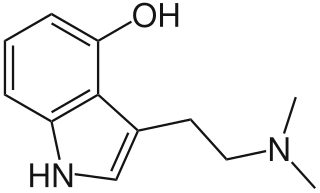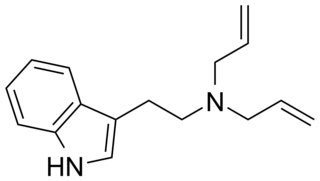
Salvinorin A is the main active psychotropic molecule in Salvia divinorum. Salvinorin A is considered a dissociative hallucinogen.

5-MeO-DMT (5-methoxy-N,N-dimethyltryptamine) or O-methyl-bufotenin is a psychedelic of the tryptamine class. It is found in a wide variety of plant species, and also is secreted by the glands of at least one toad species, the Colorado River toad. Like its close relatives DMT and bufotenin (5-HO-DMT), it has been used as an entheogen in South America. Slang terms include Five-methoxy, the power, bufo, and toad venom.

Psilocin is a substituted tryptamine alkaloid and a serotonergic psychedelic substance. It is present in most psychedelic mushrooms together with its phosphorylated counterpart psilocybin. Psilocin is a Schedule I drug under the Convention on Psychotropic Substances. Acting on the 5-HT2A receptors, psilocin modulates the production and reuptake of serotonin. The mind-altering effects of psilocin are highly variable and subjective and resemble those of LSD and DMT.

5-MeO-DALT or N,N-di allyl-5-methoxy tryptamine is a psychedelic tryptamine first synthesized by Alexander Shulgin.

4-HO-MiPT is a synthetic substituted aromatic compound and a lesser-known psychedelic tryptamine. It is thought to be a serotonergic psychedelic, similar to magic mushrooms, LSD and mescaline. Its molecular structure and pharmacological effects somewhat resemble those of the tryptamine psilocin, which is the primary psychoactive chemical in magic mushrooms.

5,N,N-trimethyltryptamine is a tryptamine derivative that is a psychedelic drug. It was first made in 1958 by Edwin H. P. Young. In animal experiments it was found to be in between DMT and 5-MeO-DMT in potency which would suggest an active dosage for humans in the 20–60 mg range. Human psychoactivity for this compound has been claimed in reports on websites such as Erowid but has not been independently confirmed.

N,N-Dibutyltryptamine (DBT) is a psychedelic drug belonging to the tryptamine family. It is found either as its crystalline hydrochloride salt or as an oily or crystalline base. DBT was first synthesized by the chemist Alexander Shulgin and reported in his book TiHKAL . Shulgin did not test DBT himself, but reports a human dosage of "1 mg/kg i.m." being active, but less so than DMT or DET. This suggests that an active dosage of DBT will be in the 100 mg range. This compound has been sold as a "research chemical" and has been confirmed to be an active hallucinogen although somewhat weaker than other similar tryptamine derivatives. It produces a head-twitch response in mice.

Dimemebfe (5-MeO-BFE) is a recreational drug and research chemical. It acts as an agonist for the 5-HT1A and 5-HT2 family of serotonin receptors. It is related in structure to the psychedelic tryptamine derivative 5-MeO-DMT, but with the indole nitrogen replaced by oxygen, making dimemebfe a benzofuran derivative. It is several times less potent as a serotonin agonist than 5-MeO-DMT and with relatively more activity at 5-HT1A, but still shows strongest effects at the 5-HT2 family of receptors.

N,N-Diallyltryptamine (DALT) is a tryptamine derivative which has been identified as a new psychoactive substance. It has been used as an intermediate in the preparation of radiolabeled diethyltryptamine.

5-Ethoxy-DMT is a tryptamine derivative which has been previously synthesized as a chemical intermediate, but has not been studied to determine its pharmacology.

Methylpropyltryptamine is a tryptamine. It is a homolog of methylethyltryptamine.

4-HO-DsBT (4-hydroxy-N,N-di-sec-butyltryptamine) is a tryptamine derivative which acts as a serotonin receptor agonist. It was first made by Alexander Shulgin and is mentioned in his book TiHKAL, but was never tested by him. However it has subsequently been tested in vitro and unlike the n-butyl and isobutyl isomers which are much weaker, the s-butyl derivative retains reasonable potency, with a similar 5-HT2A receptor affinity to MiPT but better selectivity over the 5-HT1A and 5-HT2B subtypes.

5-HO-DiPT (5-hydroxy-N,N-di-iso-propyltryptamine) is a tryptamine derivative which acts as a serotonin receptor agonist. It is primarily known as a metabolite of the better known psychoactive drug 5-MeO-DiPT, but 5-HO-DiPT has also rarely been encountered as a designer drug in its own right. Tests in vitro show 5-HO-DiPT to have high 5-HT2A affinity and good selectivity over 5-HT1A, while being more lipophilic than the related drug bufotenine (5-HO-DMT), which produces mainly peripheral effects.

QMPSB is an arylsulfonamide-based synthetic cannabinoid that has been sold as a designer drug.

ECPLA (N-ethyl-N-cyclopropyllysergamide) is an analog of lysergic acid diethylamide (LSD) developed by Synex Synthetics. In studies in mice, it was found to have approximately 40% the potency of LSD.

4-Propionoxy-N,N-dimethyltryptamine is a synthetic psychedelic drug from the tryptamine family with psychedelic effects, and is believed to act as a prodrug for psilocin. It produces a head-twitch response in mice. It has been sold online as a designer drug since May 2019. It was first identified as a new psychoactive substance in Sweden, in July 2019.

5-MeO-MET (5-Methoxy-N-methyl-N-ethyltryptamine) is a relatively rare designer drug from the substituted tryptamine family, related to compounds such as N-methyl-N-ethyltryptamine and 5-MeO-DMT. It was first synthesised in the 1960s and was studied to a limited extent, but was first identified on the illicit market in June 2012 in Sweden. It was made illegal in Norway in 2013, and is controlled under analogue provisions in numerous other jurisdictions.

MALT is a lesser-known drug from the tryptamine family. It is a novel compound with very little history of human use. It is closely related to methylpropyltryptamine (MPT), as well as N-methyltryptamine. It has been sold online as a designer drug. Very little information on the pharmacology or toxicity of MALT is available.

4-HO-MALT (4-hydroxy-N-methyl-N-allyltryptamine) is a tryptamine derivative which has been sold as a designer drug, first being detected in Slovenia in 2021.




















